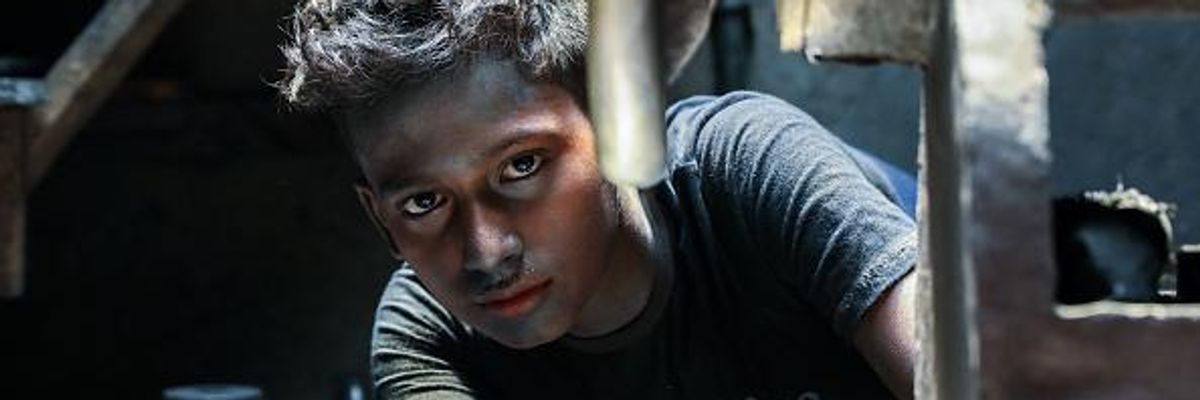Nearly 50 million people were trapped in forced labor or forced marriage on any given day in 2021, according to a new report published Monday, the latest reminder that "the scourge of modern slavery has by no means been relegated to history."
"Nothing can justify the persistence of this fundamental abuse of human rights."
The International Labour Organization (ILO), Walk Free, and the International Organization for Migration (IOM) found that the number of people around the globe living in slavery--defined as a situation of "exploitation that a person cannot refuse or cannot leave because of threats, violence, coercion, deception, or abuse of power"--increased by 9.3 million from 2016 to 2021.
By the authors' estimate, nearly one out of every 150 individuals on Earth was enslaved last year. That includes 27.6 million in forced labor, up from 24.9 million five years ago, and 22 million in forced marriages, up from 15.4 million a half-decade ago.
"It is shocking that the situation of modern slavery is not improving," ILO Director-General Guy Ryder said in a statement. "Nothing can justify the persistence of this fundamental abuse of human rights."
As the report makes clear, "compounding crises--the Covid-19 pandemic, armed conflicts, and climate change--in recent years have led to unprecedented disruption to employment and education, increases in extreme poverty and forced and unsafe migration, and an upsurge in reports of gender-based violence."
This confluence of factors serves "to heighten the risk of all forms of modern slavery," says the report. "As is usually the case, it is those who are already in situations of greatest vulnerability--including the poor and socially excluded, workers in the informal economy, irregular or otherwise unprotected migrant workers, and people subject to discrimination--who are most affected."
Modern slavery "occurs in almost every country in the world, and cuts across ethnic, cultural, and religious lines," the ILO, Walk Free, and IOM noted. "More than half (52%) of all forced labor and a quarter of all forced marriages can be found in upper-middle-income or high-income countries."
The vast majority (86%) of forced labor happens in the private sector, while the remainder (14%) is imposed by state authorities. Commercial sexual exploitation accounts for 23% of private-sector forced labor, and almost four-fifths of those trafficking victims are women or girls. The remaining 63% of private-sector forced labor occurs in other industries.
Nearly one in eight of the roughly 28 million people subjected to forced labor last year were children (3.3 million). More than half of them were trapped in commercial sexual exploitation.
Although an estimated 22 million people were living in forced marriages in 2021, the "true incidence of forced marriage, particularly involving children aged 16 and younger, is likely far greater," according to the three groups that assembled the report. While every child marriage should be considered forced "because a child cannot legally give consent to marry," current estimates "are based on a narrow definition and do not include all child marriages."
Compared with their non-migrant counterparts, migrant workers are over three times more likely to be pushed into forced labor. This injustice, the trio of organizations said, can be attributed to "irregular or poorly governed migration, or unfair and unethical recruitment practices."
According to Antonio Vitorino, director-general of the IOM, the new report "underscores the urgency of ensuring that all migration is safe, orderly, and regular."
"Reducing the vulnerability of migrants to forced labor and trafficking in persons depends first and foremost on national policy and legal frameworks that respect, protect, and fulfill the human rights and fundamental freedoms of all migrants--and potential migrants--at all stages of the migration process, regardless of their migration status," said Vitorino. "The whole of society must work together to reverse these shocking trends, including through implementation of the Global Compact on Migration."
Modern slavery, said Walk Free founding director Grace Forrest, "continues to underpin our global economy," but that doesn't have to be the case.
"It is a man-made problem, connected to both historical slavery and persisting structural inequality," said Forrest. "In a time of compounding crises, genuine political will is the key to ending these human rights abuses."
Ryder, for his part, said that "we know what needs to be done, and we know it can be done."
To abolish modern slavery, the ILO, Walk Free, and IOM recommend that the following steps be taken jointly and immediately:
- Improve and enforce laws and labor inspections;
- End state-imposed forced labor;
- Implement stronger measures to combat forced labor and trafficking in business and supply chains;
- Extend social protection and strengthen legal protections, including by raising the legal age of marriage to 18 without exception;
- Address the increased risk of trafficking and forced labor for migrant workers by promoting fair and ethical recruitment; and
- Increase support for women, girls, and vulnerable individuals.
"Effective national policies and regulation are fundamental," said Ryder. "But governments cannot do this alone. International standards provide a sound basis, and an all-hands-on-deck approach is needed. Trade unions, employers' organizations, civil society, and ordinary people all have critical roles to play."

